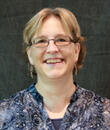
Laurel Raftery
Professor Emerita
Expertise
Cell Communication, Developmental Genetics, Epithelial Cell Biology, Fruit Fly Genetics, Cell Biology of Embryonic Development and Tissue Renewal
Degrees
Ph.D. University of Colorado, Boulder
Research
Dr. Raftery's laboratory studies how cells communicate to coordinate the formation of functioning organs. They use fruit flies as a model organism, because of the powerful genetic tools available to study cell biology in whole tissues.
In the course of a lifetime, tissues and organs must maintain their function despite environmental insults, disease, and aging. They do so using many of the same genes and proteins that were used to build the tissue during embryonic development. Both development and repair processes are tightly controlled to obtain optimal function and prevent overgrowth. In both processes, cells constantly sense their environment to make decisions about their fate, for example deciding whether to divide, migrate or differentiate. Other cells in the tissue guide these decisions by producing signals that transmit information about the state of the tissue. The resultant combination of signals coordinates individual cell decisions across the tissue to build or maintain functional architecture. Dr. Raftery's laboratory uses the fruit fly, Drosophila melanogaster, as an experimental model to investigate the genes and proteins that cells use to detect these signals and interpret them to select the appropriate fate for tissue function. Current projects in their lab focus on two general approaches to this problem.
First, they are investigating concerted migration of epithelial cells in the fly ovary. Epithelial cells are tightly connected into an organized sheet, and are essential to the function of most organs in both flies and humans. Each fly egg is formed within a structure called a follicle, which includes both germ cells and a somatic epithelium of about 650 follicle cells. This epithelium develops together with the underlying oocyte to create a functional egg. In late oogenesis, neighboring regions of the epithelium undergo distinct migrations: either moving to cover the anterior end of the oocyte or leave the epithelium to cover the apical surface of adjacent follicle cells. To investigate the mechanisms that direct these migrations, they use are variety of techniques to examine genetically manipulated follicle cells, including time-lapse micro-imaging of cultured egg chambers. Their goal is to understand how cell-cell communication mechanisms are fine-tuned to differentiate these two neighboring cell populations and drive two distinct modes of concerted cell migrations.
Second, they are investigating the mechanisms that create a “set-point” for tissue-wide responses to a specific cell communication signal. For this approach, they are focusing on the Bone Morphogenetic Proteins (BMPs), secreted proteins that organize the growth and structure of tissues and body plans in organisms from hydra to humans. BMPs have the functional properties of developmental morphogens; when present in different concentrations they induce different cell. They are using the development of the fly wing as their experimental system, and developing computational methods to analyze image data from our experiments. Their goal is to understand how intracellular mechanisms, such as crosstalk between signal transduction pathways, constrain growth and differentiation to create a wing blade of appropriate size and structure.
Additional Information
SEB Program Group: Integrative Physiology
SEB Lab Location: 3158
SEB Lab Phone Number: 702-774-1474
